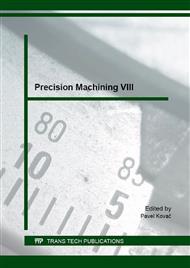[1]
F. Klocke, E. Brinksmeier, K. Weinert, Capability Profile of Hard Cutting and Grinding Processes, CIRP Annals - Manufacturing Technology 54(2) (2005) 22–45.
DOI: 10.1016/s0007-8506(07)60018-3
Google Scholar
[2]
M.N. Durakbasa, P.H. Osanna, P. Demircioglu, The factors affecting surface roughness measurements of the machined flat and spherical surface structures - The geometry and the precision of the surface, Measurement 44 (2011) 1986 – (1999).
DOI: 10.1016/j.measurement.2011.08.020
Google Scholar
[3]
B. Karpuschewski, K. Schmidt, J. Prilukova, J. Beňo, I. Maňková, N.T. Hieu, Influence of tool edge preparation on performance of ceramic tool inserts when hard turning, Journal of Materials Processing Technology, 213(11) (2013) 1978-(1988).
DOI: 10.1016/j.jmatprotec.2013.05.016
Google Scholar
[4]
I. Dudás, G. Varga, 3D topography for environmentally friendly machined surfaces, Journal of Physics: Conference Series 13 (1) (2005) 24-27.
DOI: 10.1088/1742-6596/13/1/006
Google Scholar
[5]
M.N. Durakbasa, A. Akdogan, S. Vanli, A. Gunay Bulutsuz, Optimization of end milling parameters and determination of the effects of edge profile for high surface quality of AISI H13 steel by using precise and fast measurements, Measurement 68 (2015).
DOI: 10.1016/j.measurement.2015.02.042
Google Scholar
[6]
H. Sasahara, The effect on fatigue life of residual stress and surface hardness resulting from different cutting conditions of 0. 45%C steel, International Journal of Machine Tools and Manufacture 45 (2005) 131-136.
DOI: 10.1016/j.ijmachtools.2004.08.002
Google Scholar
[7]
R. M'Saoubi, J.C. Outeiro, H. Chandrasekaran, O.W. Dillon Jr., I.S. Jawahir, A review of surface integrity in machining and its impact on functional performance and life of machined products, International Journal of Sustainable Manufacturing 1 (2008).
DOI: 10.1504/ijsm.2008.019234
Google Scholar
[8]
E.K. Henriksen, Residual stresses in machined surfaces, Trans. ASME 73 (1951) 69-74.
Google Scholar
[9]
E. Capello, Residual stresses in turning Part I: Influence of process parameters, Journal of Materials Processing Technology 160 (2005) 221–228.
DOI: 10.1016/j.jmatprotec.2004.06.012
Google Scholar
[10]
E. Capello, Residual stresses in turning Part II. Influence of the machined material, Journal of Materials Processing Technology 172 (2006) 319–326.
DOI: 10.1016/j.jmatprotec.2005.10.009
Google Scholar
[11]
C.R. Liu, M.M. Barash, Variables governing patterns of mechanical residual stress in a machined surface, Trans. ASME – Series B 104(3) (1982) 257-264.
DOI: 10.1115/1.3185828
Google Scholar
[12]
Y. Matsumoto, M.M. Barash, C.R. Liu, Effects of hardness on surface integrity of AISI 4340 steel, Trans. ASME – Series B 108 (1986) 169-175.
DOI: 10.1115/1.3187060
Google Scholar
[13]
J. Rech, A. Moisan, Surface integrity in finish hard turning of case-hardened steels, International Journal of Machine Tools & Manufacture 43 (2003) 543–550.
DOI: 10.1016/s0890-6955(02)00141-4
Google Scholar
[14]
P. Dahlman, F. Gunnberg, M. Jacobson, The influence of rake angle, cutting feed and cutting depth on residual stresses in hard turning, Journal of Materials Processing Technology 147 (2004) 181–184.
DOI: 10.1016/j.jmatprotec.2003.12.014
Google Scholar
[15]
G. Varga, I. Dudas, Modelling and examinations of dry machining processes, Proceedings of the IASTED International Conference on Modelling, Simulation, and Optimization (2004) 327-331.
Google Scholar
[16]
W. Zebala, B. Slodki, Cutting data correction in Inconel 718 turning, International Journal of Advanced Manufacturing Technology 65 (5-8) (2013) 881-893.
DOI: 10.1007/s00170-012-4225-x
Google Scholar
[17]
B. Slodki, W. Zebala, G. Struzikiewicz, Correlation Between Cutting Data Selection and Chip Form in Stainless Steel Turning, Machining Science and Technology 19(2) (2015) 217-235.
DOI: 10.1080/10910344.2015.1018530
Google Scholar
[18]
C. Maranhão, J.P. Davim, Residual stresses in machining using FEM analysis – A review, Reviews of Advanced Materials Science 30 (2012) 267-272.
Google Scholar
[19]
J.L. Li, L.L. Jing, M. Chen, An FEM study on residual stresses induced by high-speed end-milling of hardened steel SKD11, Journal of Materials Processing Technology 209(9) (2009) 4515–4520.
DOI: 10.1016/j.jmatprotec.2008.10.042
Google Scholar
[20]
P. Niesłony, W. Grzesik, P. Laskowski, J. Sienawski, Numerical and Experimental Analysis of Residual Stresses Generated in the Machining of Ti6Al4V Titanium Alloy, Procedia CIRP 13 (2014) 78–83.
DOI: 10.1016/j.procir.2014.04.014
Google Scholar
[21]
A.J. Shih, Finite element analysis of the rake angle effects in orthogonal metal cutting, International Journal of Mechanical Sciences 38(1) (1995) 1–17.
DOI: 10.1016/0020-7403(95)00036-w
Google Scholar
[22]
D. Ulutan, B. Erdem Alaca, I. Lazoglu, Analytical modelling of residual stresses in machining, Journal of Materials Processing Technology 183 (2007) 77–87.
DOI: 10.1016/j.jmatprotec.2006.09.032
Google Scholar


